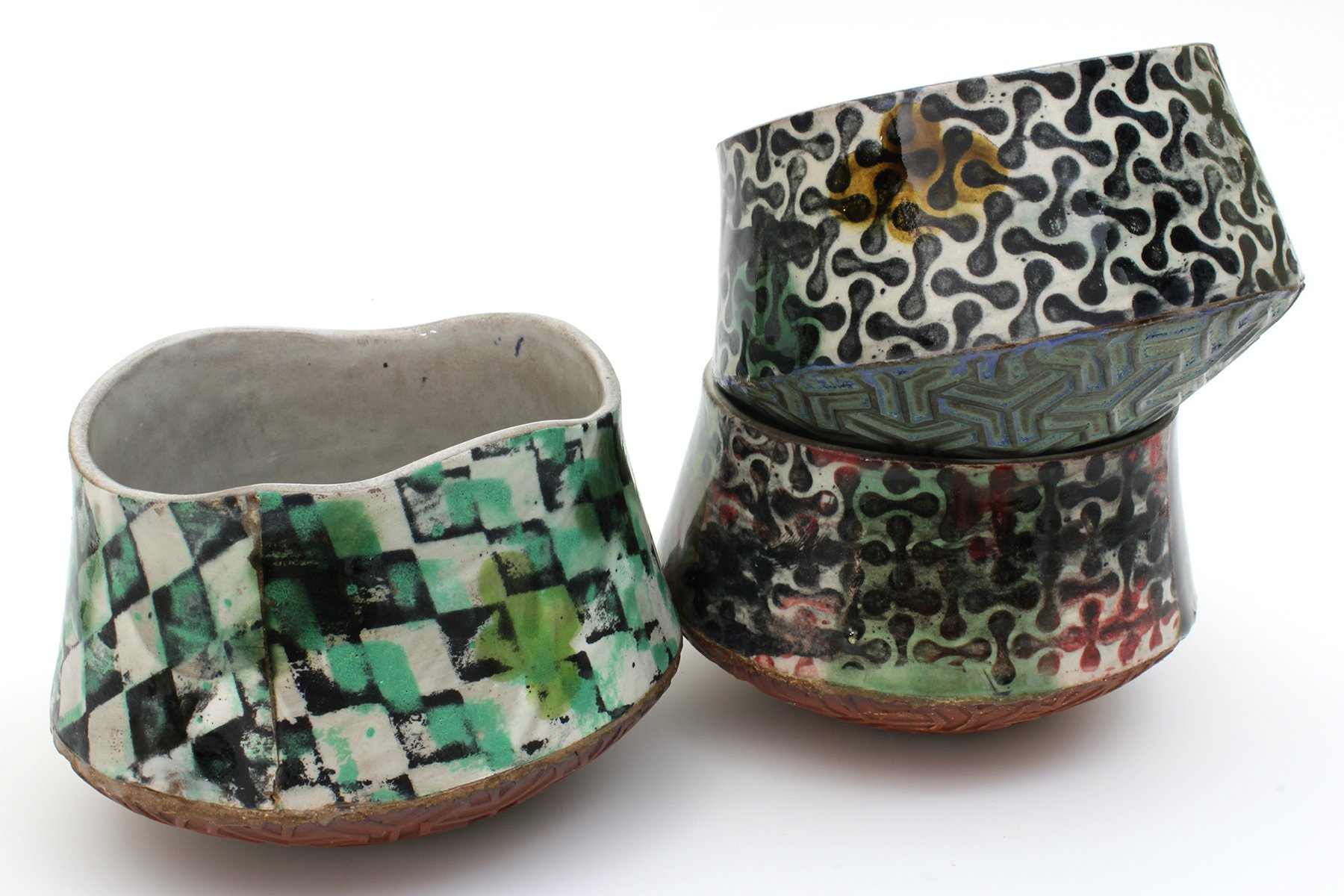Since its inception, digital technology has been seeping into nearly every aspect of our lives. It is no surprise that contemporary artists have come to use this tool in the process of creation. While digital and analog are seen as opposites, the artists in this exhibition use them seamlessly, incorporating digital technology into their process of working with traditional media.
Some artists use the computer to plan out their work, trying out different shapes and compositions. Jay Jensen models his ceramic vessels on the computer, printing out patterns for slabs he will then use to build the vessels. He also generates graphic patterns to be turned into large texture plates or image transfers. When planning her paintings, Robin Jebavy digitally manipulates photographs of glassware filled with colorful liquids, multiplying, fragmenting, repeating, and expanding patterns to create a complex compositions far more dynamic than the original still life. Much of metalsmith Adam Hawk’s recent work started by using software that uses algorithms to rapidly generate different designs. Adam then chooses the most promising of these sketches to develop in other programs before making the physical work.
Other artists use digitally controlled machines speed their process. For her Explosion series, metalsmith Melissa Cameron created patterns on the computer which she then hand sawed out of sterling silver. She was able to send these patterns directly to a laser cutter to rapidly cut the complex shapes out of other metals. Alex Dodge uses a physics engine to model the distortion of pattern on paper or fabric as they would crumple or drape. To make his incredibly tactile paintings, he has these patterns cut out of chipboard for a stencil capable of producing raised areas of thick paint or into wood blocks he can then press into soft paint, creating a letterpress effect. In his talk for Brooklyn Research, an interdisciplinary space focused on technological innovation, research, and creative practice, Alex said:
When we talk about simulation, or really any kind of digital technology, most of the time, when it comes down to it, it’s about making things faster and more convenient. I don’t think there’s anything that I’ve made a painting of yet that couldn’t be done purely with some physical setup . . . In many ways, the way that I feel is that we have to compete with an environment that is often times so fast paced that it’s hard. How do we do things that remain interesting to ourselves when so much is changing around us so quickly? . . . What might have been interesting to do ten years ago or more with painstaking labor and might have felt really fulfilling, in a way doesn’t feel that way maybe to some people now. Definitely to me I feel like, yeah, if I can cut this stencil with a machine that doesn’t really matter that much to me because ultimately what I want is something that can produce a tactile, physical painted effect or material on the canvas.
For Emily Scheider Berens and Liz Ruest, technology allows them to layer and alter the materials of their digital collages in ways they wouldn’t be able to if working with only the physical materials. Both artists begin with physical papers, prints, and hand-drawn marks before scanning them in to use as layers, brushes, or textures. Emily says:
I believe enmeshing analog and digital elements provides a unique opportunity for storytelling; I view each component within my collage compositions (which often reach 200 layers or more!) as a celebration of materiality. Mapping the process of repetition through the collection and repetition of marks and found objects is important to me- building a heightened understanding of a place or workflow by charting the same path repeatedly, and observing markers of growth and how new iterations evolve over time through slight variation.
Featured Artists:
















